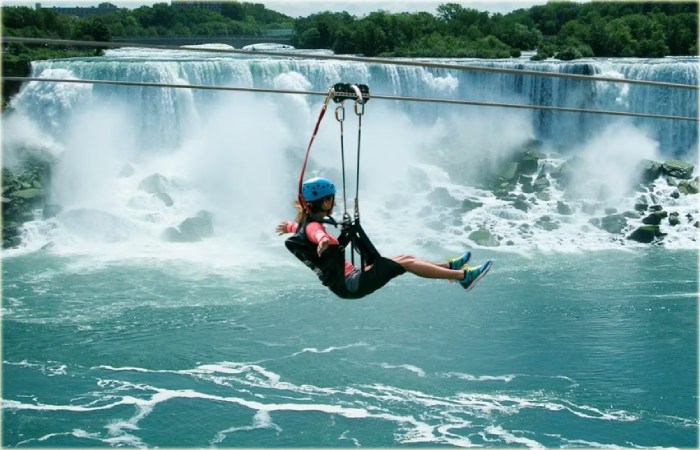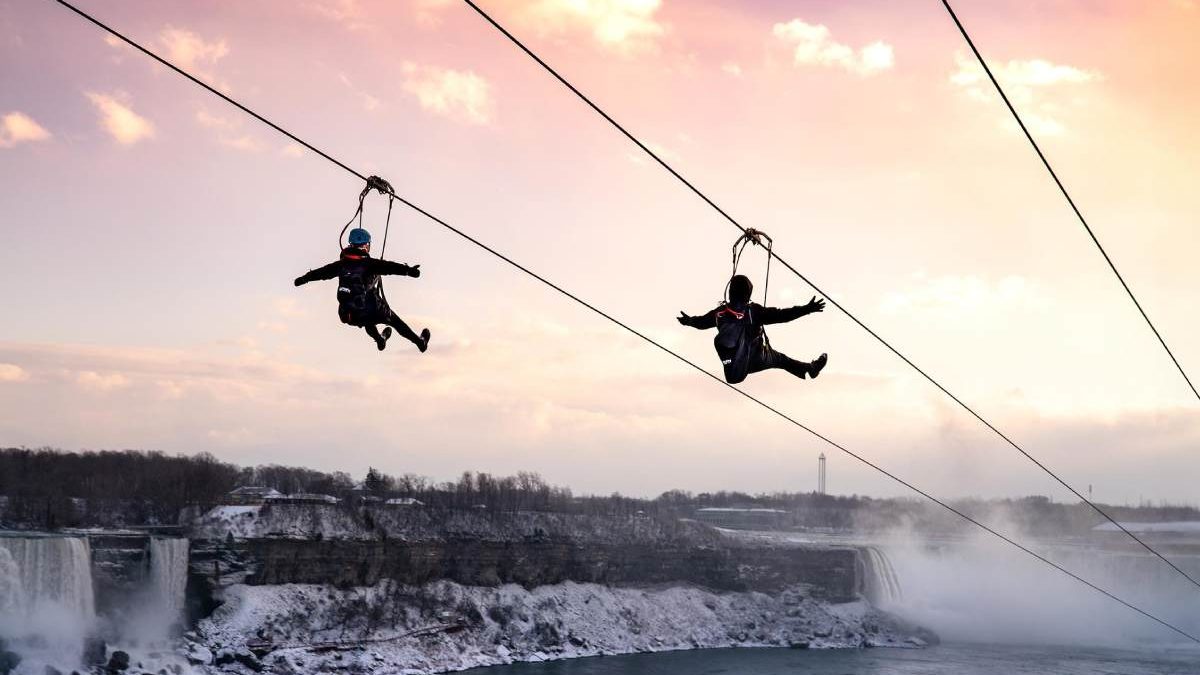Table of Contents
Introduction
Niagara Falls Zipline tours have grown in popularity in recent years, but they haven’t always been fun and games. The origins of this recreational activity are surprisingly practical. The zipline’s function has evolved over time, from a means of rapid transportation to a scientific research tool and an ecotourism icon.
Furthermore, Jumping barrels over Niagara Falls is old news. There’s a new, adrenaline-filled way to experience North America’s most powerful waterfalls: ziplining.
Although, it is located on the Canadian side of the Cascades that straddle the US border, WildPlay’s MistRider Zipline to the Falls propels riders 2,200 feet through the Niagara River Gorge at speeds up to 40 mph. From an exhilarating vantage point 220 feet above sea level, ziplines head directly to Horseshoe Falls in the United States and Canada.
MistRider (as it is known locally) consists of four parallel zip lines. Although the ends of the lines are about a kilometre from the falls, you’re virtually guarantee to feel fog on your face as you follow a guide. Add to that the fact that you’re ziplining directly into the falls, and the ride is sure to elicit screams from even the most stoic of zippers.
What is a Zipline?
A zip line is defined as a cable suspended over a slope to which a pulley and harness for a riders are attach. The inclination of a zip line which allows the riders to be pull by gravity along the line. Today, zip lines are mainly used for recreational purposes, such as ecotourism. Moreover, on these tours, guests can explore the beauty of islands like Maui and Kauai from above without leaving a large carbon footprint on the area.
Furthermore, historical evidence shows that zip lines were use in the Himalayas and the Alps for multiple purposes, including transportation. People in these areas hung zip lines to cross dangerous areas. They also used zip lines to receive or send supplies from one place to another. Ziplines in these areas were use as an alternative means of transportation to bridges because they were much quicker to build and use.
Once in a Lifetime Experience

The Ziplining to WildPlay Falls is a hands-free, worry-free, and fully guided experience for thrill-seekers and hesitant alike. Enjoy the thrill of adventure and breathtaking views of Niagara Falls with this unique opportunity for guests aged seven and over.
Wildplay Zipline to the Falls
This featherless flight is the coolest way for humans to take to the skies, now with breathtaking views of the wonders of the world at Niagara Falls! On four parallel zip lines in front of Horseshoe Falls in the United States and Canada, riders swing from a precarious vantage point 220 feet (67 meters) high. Our fully guided experience adds excitement to the stunning panorama as gravity floats passengers 670 meters (2,200 feet), at speeds of over 70 km/h (40+ mph), along the edge from the vast river gorge Niagara to Falls Viewing Landing. Feel the incredible force of nature on your face!
WildPlay Element Parks at Niagara Falls
The zip line is part of WildPlay Element Parks in Niagara Falls, a family-friendly outdoor adventure theme park with outposts across Canada. In addition to ziplining, this park offers cliffside adventure courses that include aerial climbing, jumping and swing games, as well as free line jumping (much like bungee jumping).
So, perhaps the only downside to these experiences is the age and weight limitations. 1: No one under the age of five may ride the zipline, free-line jump or run the ropes course, and the extreme weight limit for zipline users is 275 pounds.
Furthermore, the good news is that there’s also a separate obstacle course designed especially for kids, complete with a much shorter zip line so little ones don’t feel left out. (A responsible adult must accompany children under 13 years of age to the venue.) If you qualify, admission for a single zipline ride is $50. The Mistrider Zipline to the Falls opens for the 2019 season in April. Go downstairs and enjoy the great view.
Ziplining Today
Modern zip lining was made popular by wildlife biologists. In the 1970s, biologists were looking for a way to study and explore. The densely forested areas of Costa Rica without disturbing the environment. Rainforest ecosystems were the main areas they want to explore. Wildlife biologists have installed zip lines throughout the Costa Rican rainforest. The zip lines allowed them to get an aerial view of the forested areas and realistically witness natural events within the ecosystem.
Furthermore, all of this was done without disturbing the environment in which they were studying. That’s when the business idea for zipline ecotours was born. Once the biologists’ research in Costa Rica was complete, the zip lines were transform into a recreational canopy excursion. Ziplines in Costa Rica have become a popular tourist activity. Because they allow you to see and experience the area without disturbing the environment. This travel idea quickly spread from Costa Rica to many parts of the world.

